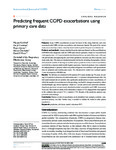Predicting frequent COPD exacerbations using primary care data
| dc.contributor.author | Price, D | |
| dc.contributor.author | Kerkhof, M | |
| dc.contributor.author | Freeman, D | |
| dc.contributor.author | Jones, Rupert | |
| dc.contributor.author | Chisholm, A | |
| dc.date.accessioned | 2016-01-18T11:52:07Z | |
| dc.date.available | 2016-01-18T11:52:07Z | |
| dc.date.issued | 2015 | |
| dc.identifier.issn | 1178-2005 | |
| dc.identifier.issn | 1178-2005 | |
| dc.identifier.uri | http://hdl.handle.net/10026.1/4213 | |
| dc.description.abstract |
PURPOSE: Acute COPD exacerbations account for much of the rising disability and costs associated with COPD, but data on predictive risk factors are limited. The goal of the current study was to develop a robust, clinically based model to predict frequent exacerbation risk. PATIENTS AND METHODS: Patients identified from the Optimum Patient Care Research Database (OPCRD) with a diagnostic code for COPD and a forced expiratory volume in 1 second/forced vital capacity ratio <0.7 were included in this historical follow-up study if they were ≥40 years old and had data encompassing the year before (predictor year) and year after (outcome year) study index date. The data set contained potential risk factors including demographic, clinical, and comorbid variables. Following univariable analysis, predictors of two or more exacerbations were fed into a stepwise multivariable logistic regression. Sensitivity analyses were conducted for subpopulations of patients without any asthma diagnosis ever and those with questionnaire data on symptoms and smoking pack-years. The full predictive model was validated against 1 year of prospective OPCRD data. RESULTS: The full data set contained 16,565 patients (53% male, median age 70 years), including 9,393 patients without any recorded asthma and 3,713 patients with questionnaire data. The full model retained eleven variables that significantly predicted two or more exacerbations, of which the number of exacerbations in the preceding year had the strongest association; others included height, age, forced expiratory volume in 1 second, and several comorbid conditions. Significant predictors not previously identified included eosinophilia and COPD Assessment Test score. The predictive ability of the full model (C statistic 0.751) changed little when applied to the validation data set (n=2,713; C statistic 0.735). Results of the sensitivity analyses supported the main findings. CONCLUSION: Patients at risk of exacerbation can be identified from routinely available, computerized primary care data. Further study is needed to validate the model in other patient populations. | |
| dc.format.extent | 2439-2439 | |
| dc.format.medium | Electronic-eCollection | |
| dc.language | en | |
| dc.language.iso | eng | |
| dc.publisher | Informa UK Limited | |
| dc.subject | prediction | |
| dc.subject | risk factor | |
| dc.subject | model | |
| dc.subject | validation | |
| dc.subject | FEV1 | |
| dc.title | Predicting frequent COPD exacerbations using primary care data | |
| dc.type | journal-article | |
| dc.type | Journal Article | |
| dc.type | Research Support, Non-U.S. Gov't | |
| plymouth.author-url | https://www.webofscience.com/api/gateway?GWVersion=2&SrcApp=PARTNER_APP&SrcAuth=LinksAMR&KeyUT=WOS:000364292800001&DestLinkType=FullRecord&DestApp=ALL_WOS&UsrCustomerID=11bb513d99f797142bcfeffcc58ea008 | |
| plymouth.issue | 1 | |
| plymouth.volume | 10 | |
| plymouth.publication-status | Published online | |
| plymouth.journal | International Journal of Chronic Obstructive Pulmonary Disease | |
| dc.identifier.doi | 10.2147/copd.s94259 | |
| plymouth.organisational-group | /Plymouth | |
| plymouth.organisational-group | /Plymouth/Faculty of Health | |
| plymouth.organisational-group | /Plymouth/REF 2021 Researchers by UoA | |
| plymouth.organisational-group | /Plymouth/REF 2021 Researchers by UoA/UoA03 Allied Health Professions, Dentistry, Nursing and Pharmacy | |
| plymouth.organisational-group | /Plymouth/REF 2021 Researchers by UoA/UoA03 Allied Health Professions, Dentistry, Nursing and Pharmacy/UoA03 Allied Health Professions, Dentistry, Nursing and Pharmacy MANUAL | |
| plymouth.organisational-group | /Plymouth/Research Groups | |
| plymouth.organisational-group | /Plymouth/Research Groups/FoH - Community and Primary Care | |
| plymouth.organisational-group | /Plymouth/Research Groups/Institute of Health and Community | |
| plymouth.organisational-group | /Plymouth/Research Groups/Institute of Translational and Stratified Medicine (ITSMED) | |
| plymouth.organisational-group | /Plymouth/Research Groups/Institute of Translational and Stratified Medicine (ITSMED)/CCT&PS | |
| plymouth.organisational-group | /Plymouth/Users by role | |
| dc.publisher.place | New Zealand | |
| dc.identifier.eissn | 1178-2005 | |
| dc.rights.embargoperiod | Not known | |
| rioxxterms.versionofrecord | 10.2147/copd.s94259 | |
| rioxxterms.licenseref.uri | http://www.rioxx.net/licenses/all-rights-reserved | |
| rioxxterms.type | Journal Article/Review |


